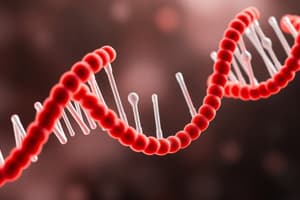Podcast
Questions and Answers
What is the basic unit of structure and function in all living organisms?
What is the basic unit of structure and function in all living organisms?
- System
- Organ
- Tissue
- Cell (correct)
Who discovered the cell in 1665?
Who discovered the cell in 1665?
- Robert Hooke (correct)
- Anton Van Leeuwenhoek
- Theodor Schwann
- Matthias Schleiden
What is the term for organisms made up of one cell only?
What is the term for organisms made up of one cell only?
- Multicellular
- Eukaryotic
- Prokaryotic
- Unicellular (correct)
What is the process by which new cells arise?
What is the process by which new cells arise?
What is the main function of cells in multicellular organisms?
What is the main function of cells in multicellular organisms?
What is the main function of the mitochondria in a cell?
What is the main function of the mitochondria in a cell?
What is the term used to describe the cell membrane's ability to control what enters or leaves the cell?
What is the term used to describe the cell membrane's ability to control what enters or leaves the cell?
What is the primary function of lysosomes in animal cells?
What is the primary function of lysosomes in animal cells?
What is the shape of muscle cells?
What is the shape of muscle cells?
What is the largest type of cell?
What is the largest type of cell?
Flashcards are hidden until you start studying
Study Notes
Cell Structure and Function
- A cell is the basic unit of structure and function in all living organisms.
- Cells are the smallest part of the body of every living organism that can carry out all the basic functions of life.
Discovery of Cells
- Cells were first discovered by Robert Hooke in 1665 when he observed a slice of cork under a microscope.
- Anton Van Leeuwenhoek, a Dutch Scientist, later observed single-celled organisms like bacteria under a microscope.
Cell Theory
- The cell theory was proposed by three scientists: Matthias Schleiden, Theodor Schwann, and Rudolf Virchow.
- The cell theory states that:
- Every living organism is made up of one or many cells.
- A cell is the structural and functional unit of living organisms.
- New cells arise by the division of pre-existing cells.
Types of Cells
- Unicellular organisms: formed of one cell only, e.g., bacteria, Amoeba, Euglena, paramecium, Chlamydomonas, and yeast.
- Multicellular organisms: formed of many cells, e.g., Hydra, frog, trees, etc.
Shape of Cells
- Cells have different shapes related to the functions they perform.
- Examples of cell shapes:
- Muscle cells: spindle-shaped.
- Nerve cells: long and branched.
- Amoeba: irregular shape with pseudopodia.
Size of Cells
- The largest cell: ostrich egg, 15-20 cm in diameter.
- The smallest cell: red blood cells in the human body (7 micrometer) and bacteria cells (0.3-5.0 micrometer).
- The longest cell: nerve cells in the human body (1 meter).
Parts of a Cell
- A typical cell has three basic parts:
- Cell membrane (plasma membrane): a thin, elastic, and selectively permeable membrane around the cytoplasm.
- Cytoplasm: a jelly-like, semi-fluid substance found between the cell membrane and the nucleus.
- Nucleus: contains the genetic material of the cell.
Cell Wall (in Plant Cells)
- In addition to the cell membrane, plant cells have a cell wall.
- The cell wall is non-living, formed of cellulose, and provides rigidity and mechanical support to the cell.
Cell Organelles
- Mitochondria: double membrane, rod-shaped bodies that produce energy (ATP) by breaking down food during cell respiration.
- Endoplasmic Reticulum (ER): an irregular network of membranes that divide the cytoplasm into channels, helping to transport substances within the cell.
- Golgi Complex: stacks of thin membranes concerned with secretion, packaging, and transport of substances like enzymes and hormones within the cell.
- Lysosomes: small, round sacs filled with enzymes that can destroy and digest foreign substances.
- Ribosomes: tiny granules scattered in the cytoplasm or attached to the ER, responsible for protein synthesis.
Studying That Suits You
Use AI to generate personalized quizzes and flashcards to suit your learning preferences.




